Promoting Mental Health Illness and Well-Being
VerifiedAdded on 2023/01/03
|10
|2707
|82
AI Summary
This document discusses the mental health status of a client in a case study and explores the factors contributing to their current mental health status. It also examines the positive aspects of mental health recovery, including respect, empowerment, and hope, and how they can positively contribute to the client's healing journey.
Contribute Materials
Your contribution can guide someone’s learning journey. Share your
documents today.
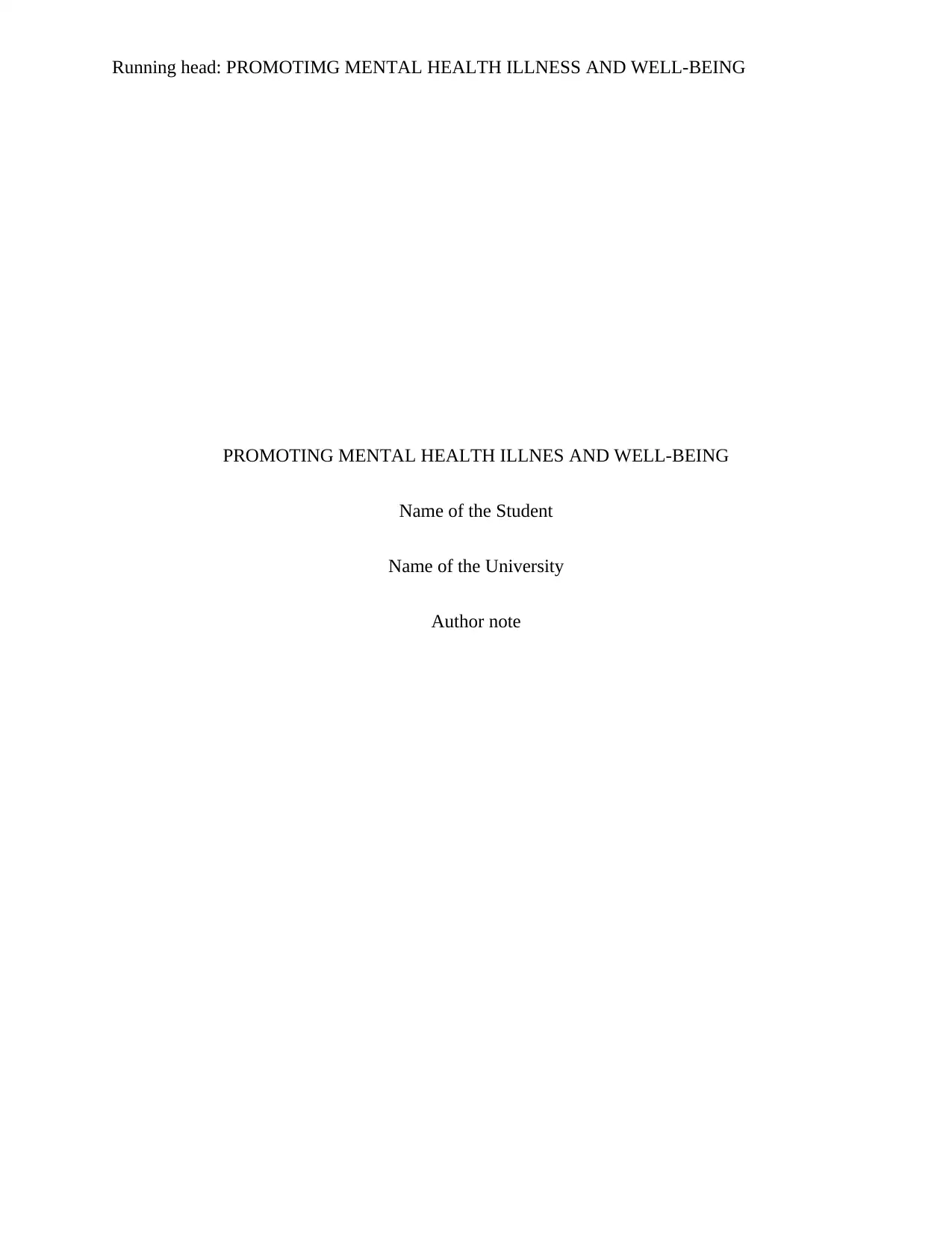
Running head: PROMOTIMG MENTAL HEALTH ILLNESS AND WELL-BEING
PROMOTING MENTAL HEALTH ILLNES AND WELL-BEING
Name of the Student
Name of the University
Author note
PROMOTING MENTAL HEALTH ILLNES AND WELL-BEING
Name of the Student
Name of the University
Author note
Secure Best Marks with AI Grader
Need help grading? Try our AI Grader for instant feedback on your assignments.
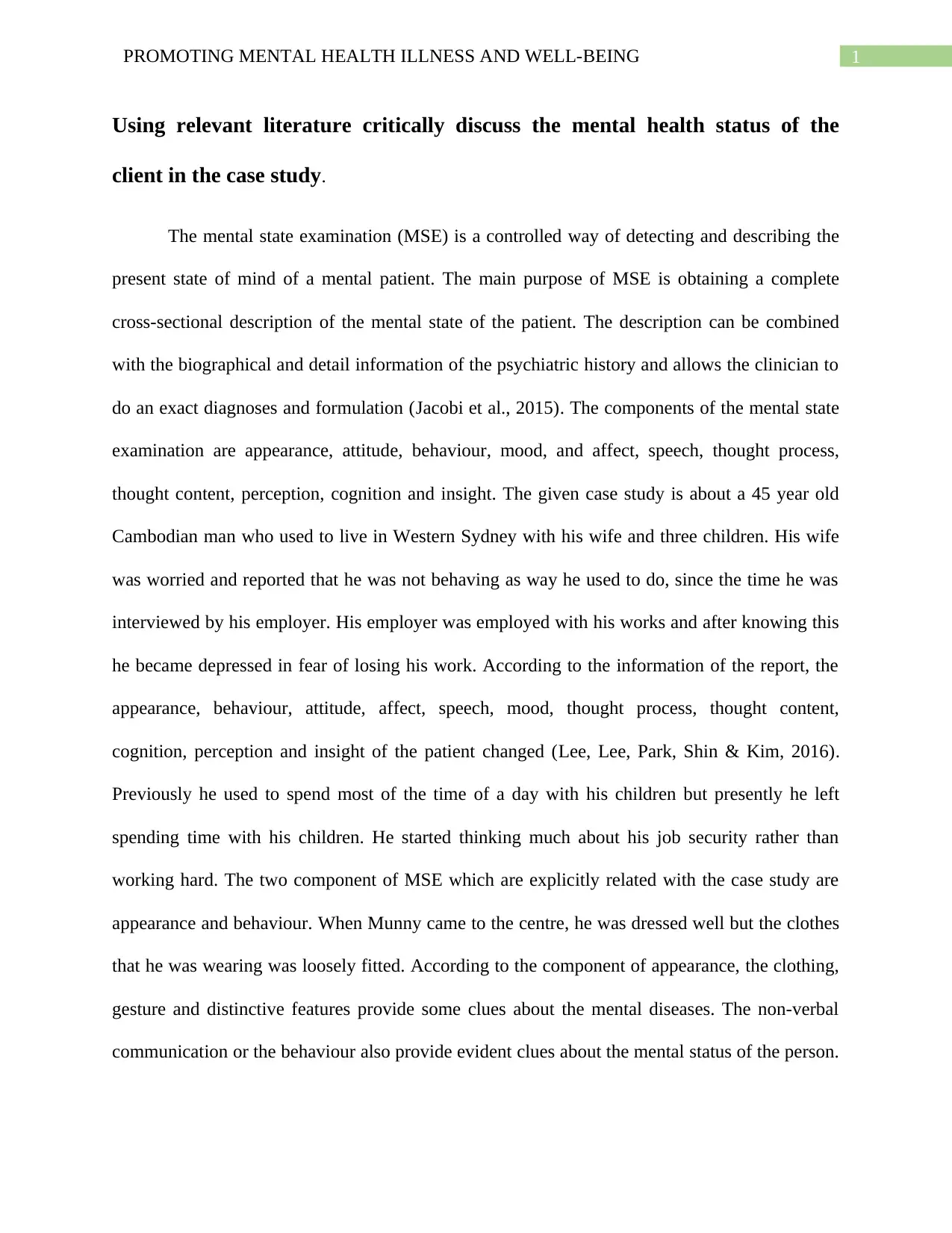
1PROMOTING MENTAL HEALTH ILLNESS AND WELL-BEING
Using relevant literature critically discuss the mental health status of the
client in the case study.
The mental state examination (MSE) is a controlled way of detecting and describing the
present state of mind of a mental patient. The main purpose of MSE is obtaining a complete
cross-sectional description of the mental state of the patient. The description can be combined
with the biographical and detail information of the psychiatric history and allows the clinician to
do an exact diagnoses and formulation (Jacobi et al., 2015). The components of the mental state
examination are appearance, attitude, behaviour, mood, and affect, speech, thought process,
thought content, perception, cognition and insight. The given case study is about a 45 year old
Cambodian man who used to live in Western Sydney with his wife and three children. His wife
was worried and reported that he was not behaving as way he used to do, since the time he was
interviewed by his employer. His employer was employed with his works and after knowing this
he became depressed in fear of losing his work. According to the information of the report, the
appearance, behaviour, attitude, affect, speech, mood, thought process, thought content,
cognition, perception and insight of the patient changed (Lee, Lee, Park, Shin & Kim, 2016).
Previously he used to spend most of the time of a day with his children but presently he left
spending time with his children. He started thinking much about his job security rather than
working hard. The two component of MSE which are explicitly related with the case study are
appearance and behaviour. When Munny came to the centre, he was dressed well but the clothes
that he was wearing was loosely fitted. According to the component of appearance, the clothing,
gesture and distinctive features provide some clues about the mental diseases. The non-verbal
communication or the behaviour also provide evident clues about the mental status of the person.
Using relevant literature critically discuss the mental health status of the
client in the case study.
The mental state examination (MSE) is a controlled way of detecting and describing the
present state of mind of a mental patient. The main purpose of MSE is obtaining a complete
cross-sectional description of the mental state of the patient. The description can be combined
with the biographical and detail information of the psychiatric history and allows the clinician to
do an exact diagnoses and formulation (Jacobi et al., 2015). The components of the mental state
examination are appearance, attitude, behaviour, mood, and affect, speech, thought process,
thought content, perception, cognition and insight. The given case study is about a 45 year old
Cambodian man who used to live in Western Sydney with his wife and three children. His wife
was worried and reported that he was not behaving as way he used to do, since the time he was
interviewed by his employer. His employer was employed with his works and after knowing this
he became depressed in fear of losing his work. According to the information of the report, the
appearance, behaviour, attitude, affect, speech, mood, thought process, thought content,
cognition, perception and insight of the patient changed (Lee, Lee, Park, Shin & Kim, 2016).
Previously he used to spend most of the time of a day with his children but presently he left
spending time with his children. He started thinking much about his job security rather than
working hard. The two component of MSE which are explicitly related with the case study are
appearance and behaviour. When Munny came to the centre, he was dressed well but the clothes
that he was wearing was loosely fitted. According to the component of appearance, the clothing,
gesture and distinctive features provide some clues about the mental diseases. The non-verbal
communication or the behaviour also provide evident clues about the mental status of the person.
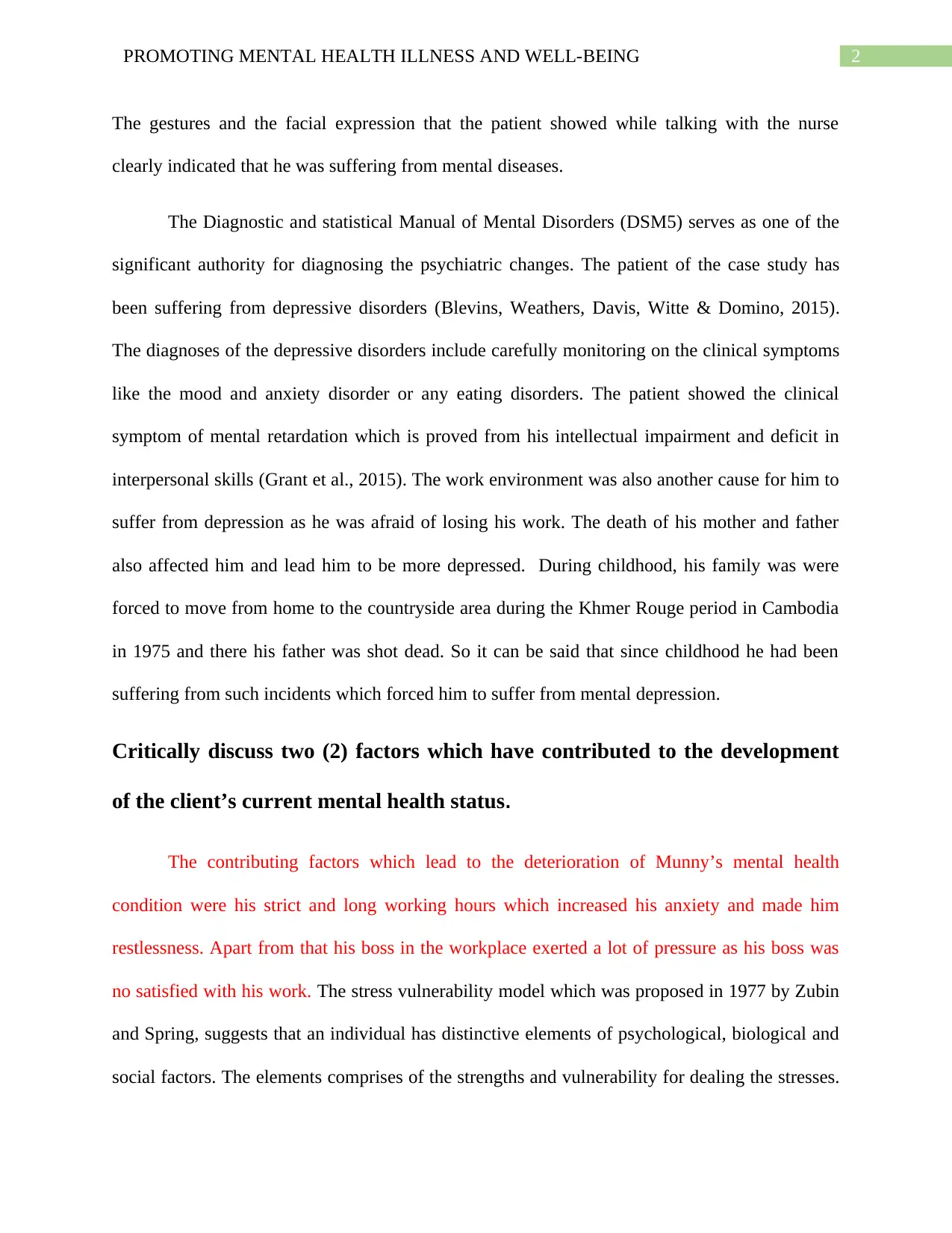
2PROMOTING MENTAL HEALTH ILLNESS AND WELL-BEING
The gestures and the facial expression that the patient showed while talking with the nurse
clearly indicated that he was suffering from mental diseases.
The Diagnostic and statistical Manual of Mental Disorders (DSM5) serves as one of the
significant authority for diagnosing the psychiatric changes. The patient of the case study has
been suffering from depressive disorders (Blevins, Weathers, Davis, Witte & Domino, 2015).
The diagnoses of the depressive disorders include carefully monitoring on the clinical symptoms
like the mood and anxiety disorder or any eating disorders. The patient showed the clinical
symptom of mental retardation which is proved from his intellectual impairment and deficit in
interpersonal skills (Grant et al., 2015). The work environment was also another cause for him to
suffer from depression as he was afraid of losing his work. The death of his mother and father
also affected him and lead him to be more depressed. During childhood, his family was were
forced to move from home to the countryside area during the Khmer Rouge period in Cambodia
in 1975 and there his father was shot dead. So it can be said that since childhood he had been
suffering from such incidents which forced him to suffer from mental depression.
Critically discuss two (2) factors which have contributed to the development
of the client’s current mental health status.
The contributing factors which lead to the deterioration of Munny’s mental health
condition were his strict and long working hours which increased his anxiety and made him
restlessness. Apart from that his boss in the workplace exerted a lot of pressure as his boss was
no satisfied with his work. The stress vulnerability model which was proposed in 1977 by Zubin
and Spring, suggests that an individual has distinctive elements of psychological, biological and
social factors. The elements comprises of the strengths and vulnerability for dealing the stresses.
The gestures and the facial expression that the patient showed while talking with the nurse
clearly indicated that he was suffering from mental diseases.
The Diagnostic and statistical Manual of Mental Disorders (DSM5) serves as one of the
significant authority for diagnosing the psychiatric changes. The patient of the case study has
been suffering from depressive disorders (Blevins, Weathers, Davis, Witte & Domino, 2015).
The diagnoses of the depressive disorders include carefully monitoring on the clinical symptoms
like the mood and anxiety disorder or any eating disorders. The patient showed the clinical
symptom of mental retardation which is proved from his intellectual impairment and deficit in
interpersonal skills (Grant et al., 2015). The work environment was also another cause for him to
suffer from depression as he was afraid of losing his work. The death of his mother and father
also affected him and lead him to be more depressed. During childhood, his family was were
forced to move from home to the countryside area during the Khmer Rouge period in Cambodia
in 1975 and there his father was shot dead. So it can be said that since childhood he had been
suffering from such incidents which forced him to suffer from mental depression.
Critically discuss two (2) factors which have contributed to the development
of the client’s current mental health status.
The contributing factors which lead to the deterioration of Munny’s mental health
condition were his strict and long working hours which increased his anxiety and made him
restlessness. Apart from that his boss in the workplace exerted a lot of pressure as his boss was
no satisfied with his work. The stress vulnerability model which was proposed in 1977 by Zubin
and Spring, suggests that an individual has distinctive elements of psychological, biological and
social factors. The elements comprises of the strengths and vulnerability for dealing the stresses.
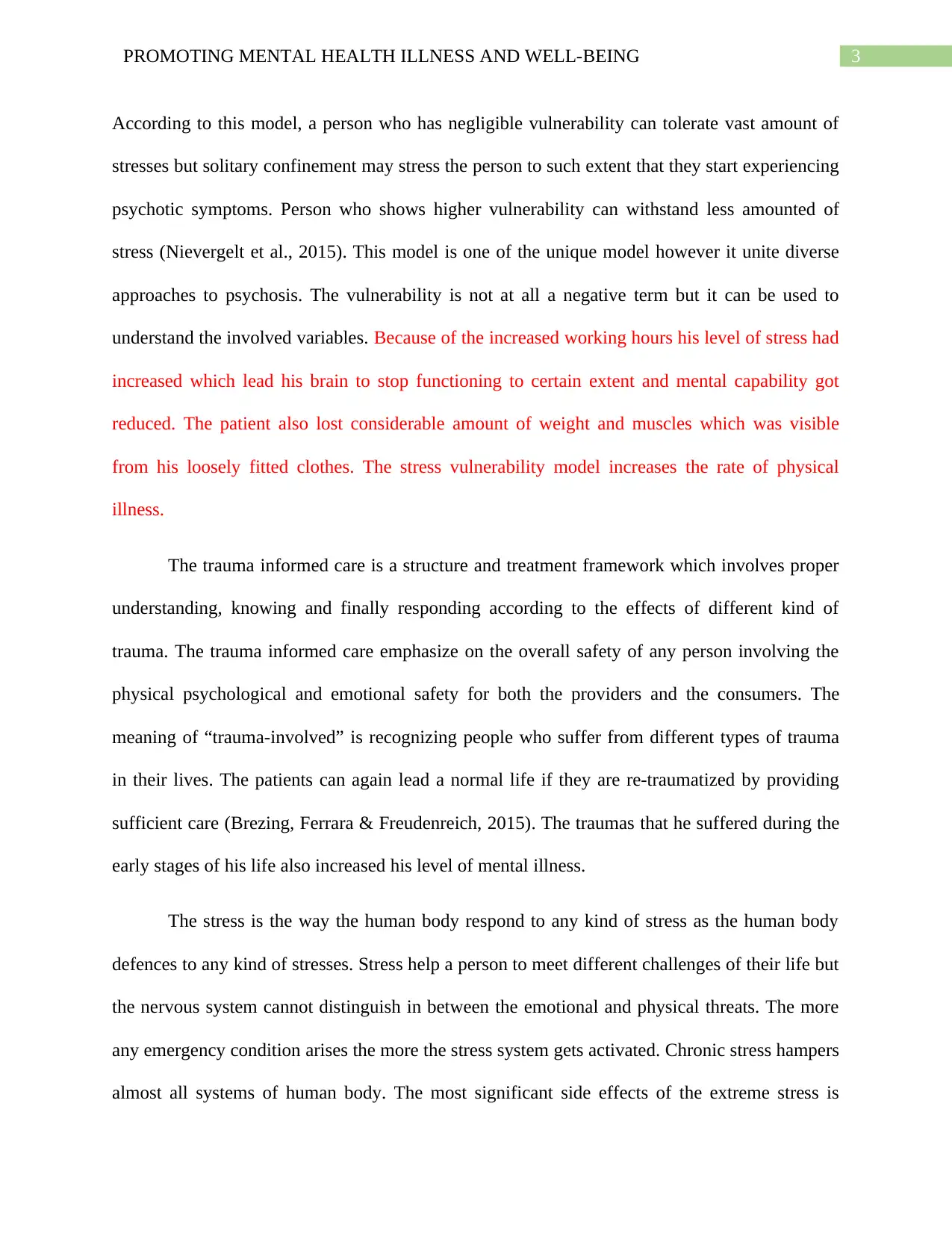
3PROMOTING MENTAL HEALTH ILLNESS AND WELL-BEING
According to this model, a person who has negligible vulnerability can tolerate vast amount of
stresses but solitary confinement may stress the person to such extent that they start experiencing
psychotic symptoms. Person who shows higher vulnerability can withstand less amounted of
stress (Nievergelt et al., 2015). This model is one of the unique model however it unite diverse
approaches to psychosis. The vulnerability is not at all a negative term but it can be used to
understand the involved variables. Because of the increased working hours his level of stress had
increased which lead his brain to stop functioning to certain extent and mental capability got
reduced. The patient also lost considerable amount of weight and muscles which was visible
from his loosely fitted clothes. The stress vulnerability model increases the rate of physical
illness.
The trauma informed care is a structure and treatment framework which involves proper
understanding, knowing and finally responding according to the effects of different kind of
trauma. The trauma informed care emphasize on the overall safety of any person involving the
physical psychological and emotional safety for both the providers and the consumers. The
meaning of “trauma-involved” is recognizing people who suffer from different types of trauma
in their lives. The patients can again lead a normal life if they are re-traumatized by providing
sufficient care (Brezing, Ferrara & Freudenreich, 2015). The traumas that he suffered during the
early stages of his life also increased his level of mental illness.
The stress is the way the human body respond to any kind of stress as the human body
defences to any kind of stresses. Stress help a person to meet different challenges of their life but
the nervous system cannot distinguish in between the emotional and physical threats. The more
any emergency condition arises the more the stress system gets activated. Chronic stress hampers
almost all systems of human body. The most significant side effects of the extreme stress is
According to this model, a person who has negligible vulnerability can tolerate vast amount of
stresses but solitary confinement may stress the person to such extent that they start experiencing
psychotic symptoms. Person who shows higher vulnerability can withstand less amounted of
stress (Nievergelt et al., 2015). This model is one of the unique model however it unite diverse
approaches to psychosis. The vulnerability is not at all a negative term but it can be used to
understand the involved variables. Because of the increased working hours his level of stress had
increased which lead his brain to stop functioning to certain extent and mental capability got
reduced. The patient also lost considerable amount of weight and muscles which was visible
from his loosely fitted clothes. The stress vulnerability model increases the rate of physical
illness.
The trauma informed care is a structure and treatment framework which involves proper
understanding, knowing and finally responding according to the effects of different kind of
trauma. The trauma informed care emphasize on the overall safety of any person involving the
physical psychological and emotional safety for both the providers and the consumers. The
meaning of “trauma-involved” is recognizing people who suffer from different types of trauma
in their lives. The patients can again lead a normal life if they are re-traumatized by providing
sufficient care (Brezing, Ferrara & Freudenreich, 2015). The traumas that he suffered during the
early stages of his life also increased his level of mental illness.
The stress is the way the human body respond to any kind of stress as the human body
defences to any kind of stresses. Stress help a person to meet different challenges of their life but
the nervous system cannot distinguish in between the emotional and physical threats. The more
any emergency condition arises the more the stress system gets activated. Chronic stress hampers
almost all systems of human body. The most significant side effects of the extreme stress is
Secure Best Marks with AI Grader
Need help grading? Try our AI Grader for instant feedback on your assignments.
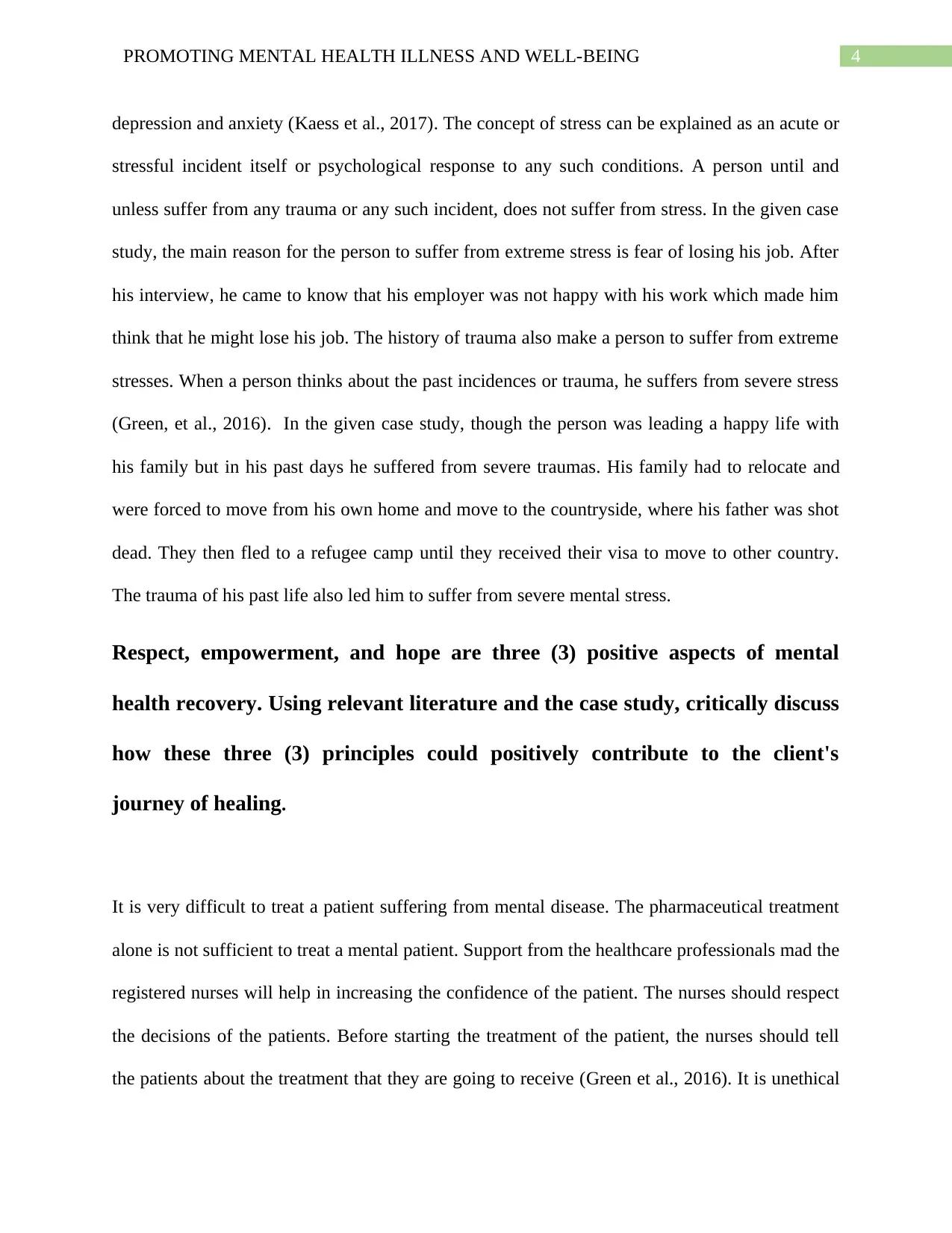
4PROMOTING MENTAL HEALTH ILLNESS AND WELL-BEING
depression and anxiety (Kaess et al., 2017). The concept of stress can be explained as an acute or
stressful incident itself or psychological response to any such conditions. A person until and
unless suffer from any trauma or any such incident, does not suffer from stress. In the given case
study, the main reason for the person to suffer from extreme stress is fear of losing his job. After
his interview, he came to know that his employer was not happy with his work which made him
think that he might lose his job. The history of trauma also make a person to suffer from extreme
stresses. When a person thinks about the past incidences or trauma, he suffers from severe stress
(Green, et al., 2016). In the given case study, though the person was leading a happy life with
his family but in his past days he suffered from severe traumas. His family had to relocate and
were forced to move from his own home and move to the countryside, where his father was shot
dead. They then fled to a refugee camp until they received their visa to move to other country.
The trauma of his past life also led him to suffer from severe mental stress.
Respect, empowerment, and hope are three (3) positive aspects of mental
health recovery. Using relevant literature and the case study, critically discuss
how these three (3) principles could positively contribute to the client's
journey of healing.
It is very difficult to treat a patient suffering from mental disease. The pharmaceutical treatment
alone is not sufficient to treat a mental patient. Support from the healthcare professionals mad the
registered nurses will help in increasing the confidence of the patient. The nurses should respect
the decisions of the patients. Before starting the treatment of the patient, the nurses should tell
the patients about the treatment that they are going to receive (Green et al., 2016). It is unethical
depression and anxiety (Kaess et al., 2017). The concept of stress can be explained as an acute or
stressful incident itself or psychological response to any such conditions. A person until and
unless suffer from any trauma or any such incident, does not suffer from stress. In the given case
study, the main reason for the person to suffer from extreme stress is fear of losing his job. After
his interview, he came to know that his employer was not happy with his work which made him
think that he might lose his job. The history of trauma also make a person to suffer from extreme
stresses. When a person thinks about the past incidences or trauma, he suffers from severe stress
(Green, et al., 2016). In the given case study, though the person was leading a happy life with
his family but in his past days he suffered from severe traumas. His family had to relocate and
were forced to move from his own home and move to the countryside, where his father was shot
dead. They then fled to a refugee camp until they received their visa to move to other country.
The trauma of his past life also led him to suffer from severe mental stress.
Respect, empowerment, and hope are three (3) positive aspects of mental
health recovery. Using relevant literature and the case study, critically discuss
how these three (3) principles could positively contribute to the client's
journey of healing.
It is very difficult to treat a patient suffering from mental disease. The pharmaceutical treatment
alone is not sufficient to treat a mental patient. Support from the healthcare professionals mad the
registered nurses will help in increasing the confidence of the patient. The nurses should respect
the decisions of the patients. Before starting the treatment of the patient, the nurses should tell
the patients about the treatment that they are going to receive (Green et al., 2016). It is unethical
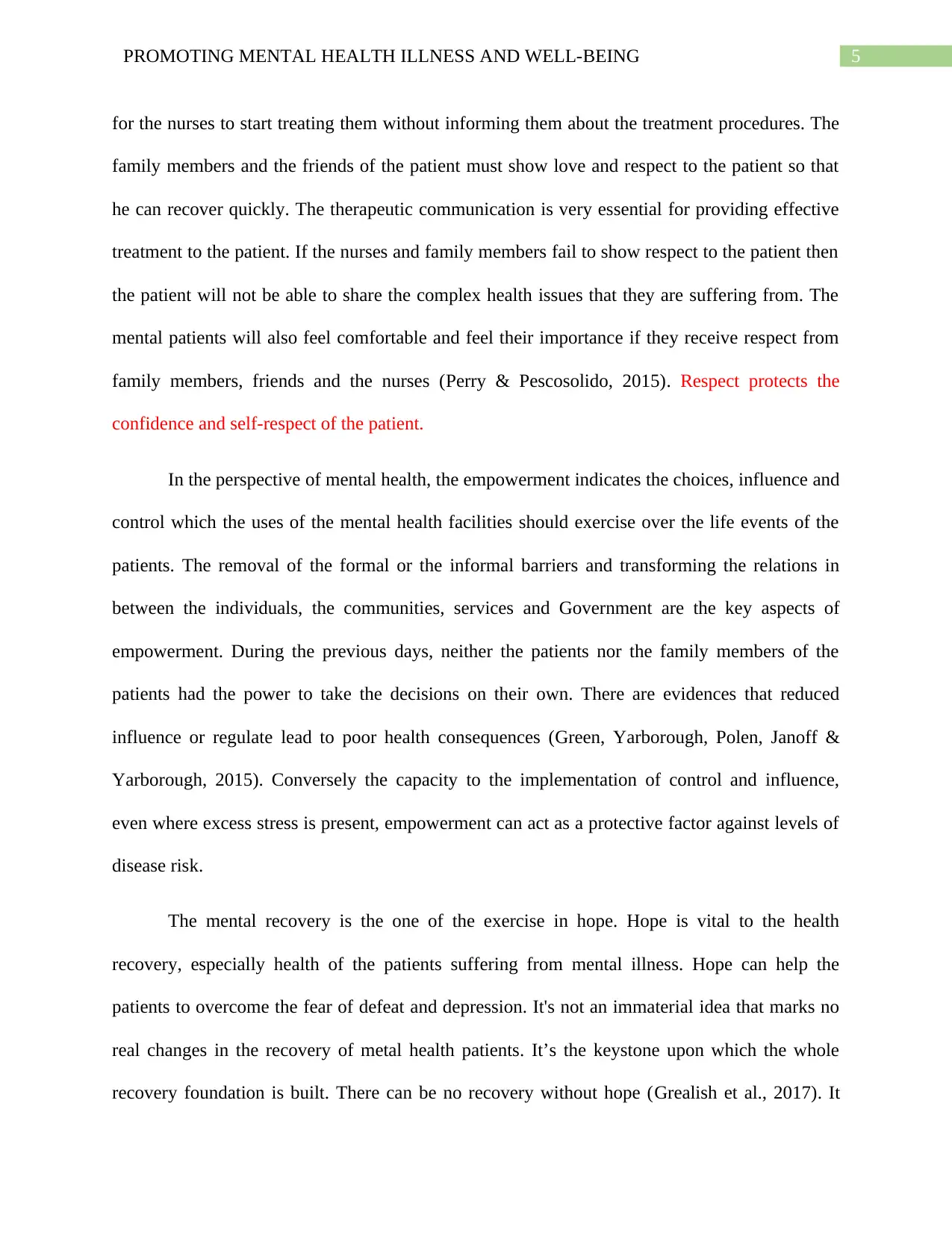
5PROMOTING MENTAL HEALTH ILLNESS AND WELL-BEING
for the nurses to start treating them without informing them about the treatment procedures. The
family members and the friends of the patient must show love and respect to the patient so that
he can recover quickly. The therapeutic communication is very essential for providing effective
treatment to the patient. If the nurses and family members fail to show respect to the patient then
the patient will not be able to share the complex health issues that they are suffering from. The
mental patients will also feel comfortable and feel their importance if they receive respect from
family members, friends and the nurses (Perry & Pescosolido, 2015). Respect protects the
confidence and self-respect of the patient.
In the perspective of mental health, the empowerment indicates the choices, influence and
control which the uses of the mental health facilities should exercise over the life events of the
patients. The removal of the formal or the informal barriers and transforming the relations in
between the individuals, the communities, services and Government are the key aspects of
empowerment. During the previous days, neither the patients nor the family members of the
patients had the power to take the decisions on their own. There are evidences that reduced
influence or regulate lead to poor health consequences (Green, Yarborough, Polen, Janoff &
Yarborough, 2015). Conversely the capacity to the implementation of control and influence,
even where excess stress is present, empowerment can act as a protective factor against levels of
disease risk.
The mental recovery is the one of the exercise in hope. Hope is vital to the health
recovery, especially health of the patients suffering from mental illness. Hope can help the
patients to overcome the fear of defeat and depression. It's not an immaterial idea that marks no
real changes in the recovery of metal health patients. It’s the keystone upon which the whole
recovery foundation is built. There can be no recovery without hope (Grealish et al., 2017). It
for the nurses to start treating them without informing them about the treatment procedures. The
family members and the friends of the patient must show love and respect to the patient so that
he can recover quickly. The therapeutic communication is very essential for providing effective
treatment to the patient. If the nurses and family members fail to show respect to the patient then
the patient will not be able to share the complex health issues that they are suffering from. The
mental patients will also feel comfortable and feel their importance if they receive respect from
family members, friends and the nurses (Perry & Pescosolido, 2015). Respect protects the
confidence and self-respect of the patient.
In the perspective of mental health, the empowerment indicates the choices, influence and
control which the uses of the mental health facilities should exercise over the life events of the
patients. The removal of the formal or the informal barriers and transforming the relations in
between the individuals, the communities, services and Government are the key aspects of
empowerment. During the previous days, neither the patients nor the family members of the
patients had the power to take the decisions on their own. There are evidences that reduced
influence or regulate lead to poor health consequences (Green, Yarborough, Polen, Janoff &
Yarborough, 2015). Conversely the capacity to the implementation of control and influence,
even where excess stress is present, empowerment can act as a protective factor against levels of
disease risk.
The mental recovery is the one of the exercise in hope. Hope is vital to the health
recovery, especially health of the patients suffering from mental illness. Hope can help the
patients to overcome the fear of defeat and depression. It's not an immaterial idea that marks no
real changes in the recovery of metal health patients. It’s the keystone upon which the whole
recovery foundation is built. There can be no recovery without hope (Grealish et al., 2017). It
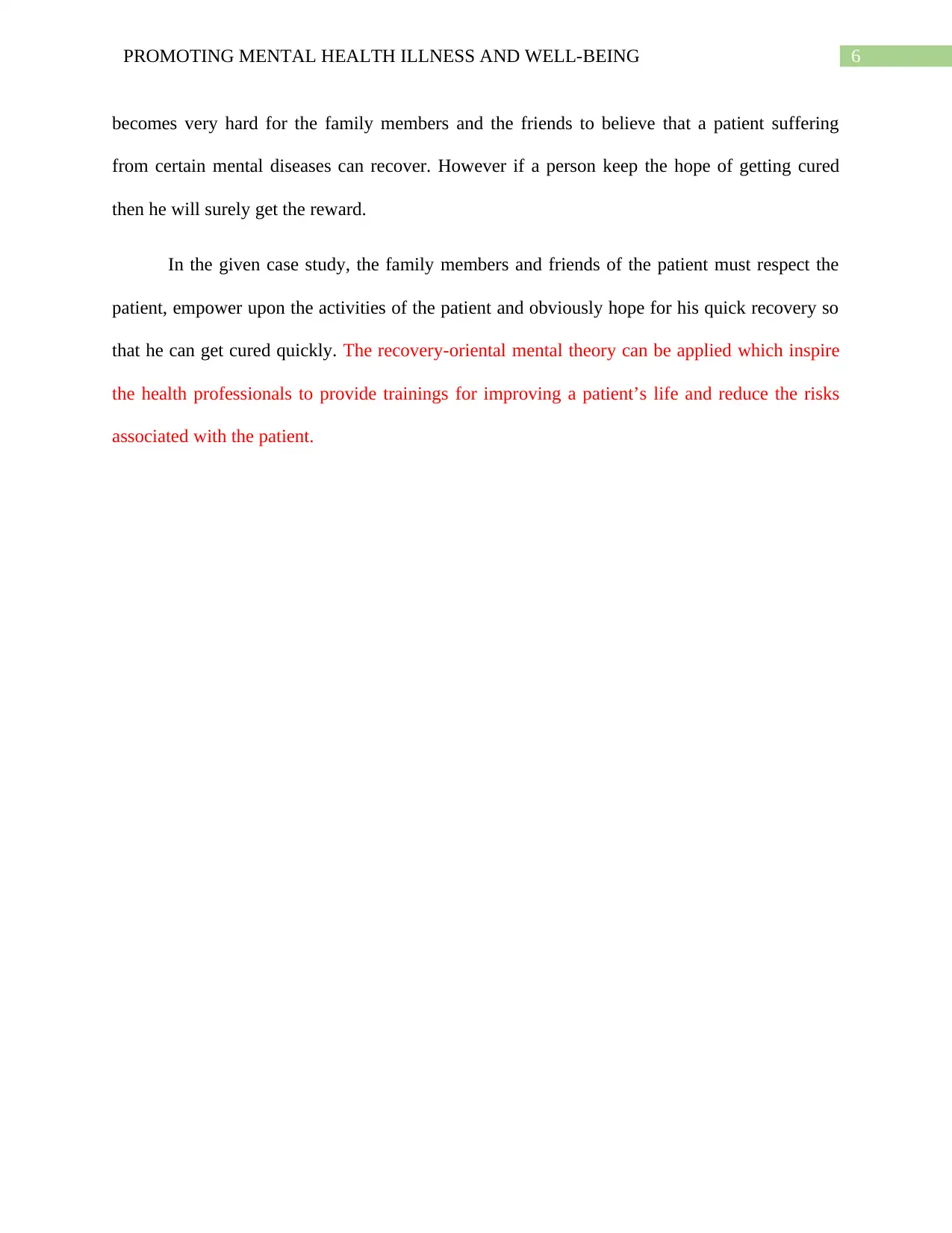
6PROMOTING MENTAL HEALTH ILLNESS AND WELL-BEING
becomes very hard for the family members and the friends to believe that a patient suffering
from certain mental diseases can recover. However if a person keep the hope of getting cured
then he will surely get the reward.
In the given case study, the family members and friends of the patient must respect the
patient, empower upon the activities of the patient and obviously hope for his quick recovery so
that he can get cured quickly. The recovery-oriental mental theory can be applied which inspire
the health professionals to provide trainings for improving a patient’s life and reduce the risks
associated with the patient.
becomes very hard for the family members and the friends to believe that a patient suffering
from certain mental diseases can recover. However if a person keep the hope of getting cured
then he will surely get the reward.
In the given case study, the family members and friends of the patient must respect the
patient, empower upon the activities of the patient and obviously hope for his quick recovery so
that he can get cured quickly. The recovery-oriental mental theory can be applied which inspire
the health professionals to provide trainings for improving a patient’s life and reduce the risks
associated with the patient.
Paraphrase This Document
Need a fresh take? Get an instant paraphrase of this document with our AI Paraphraser
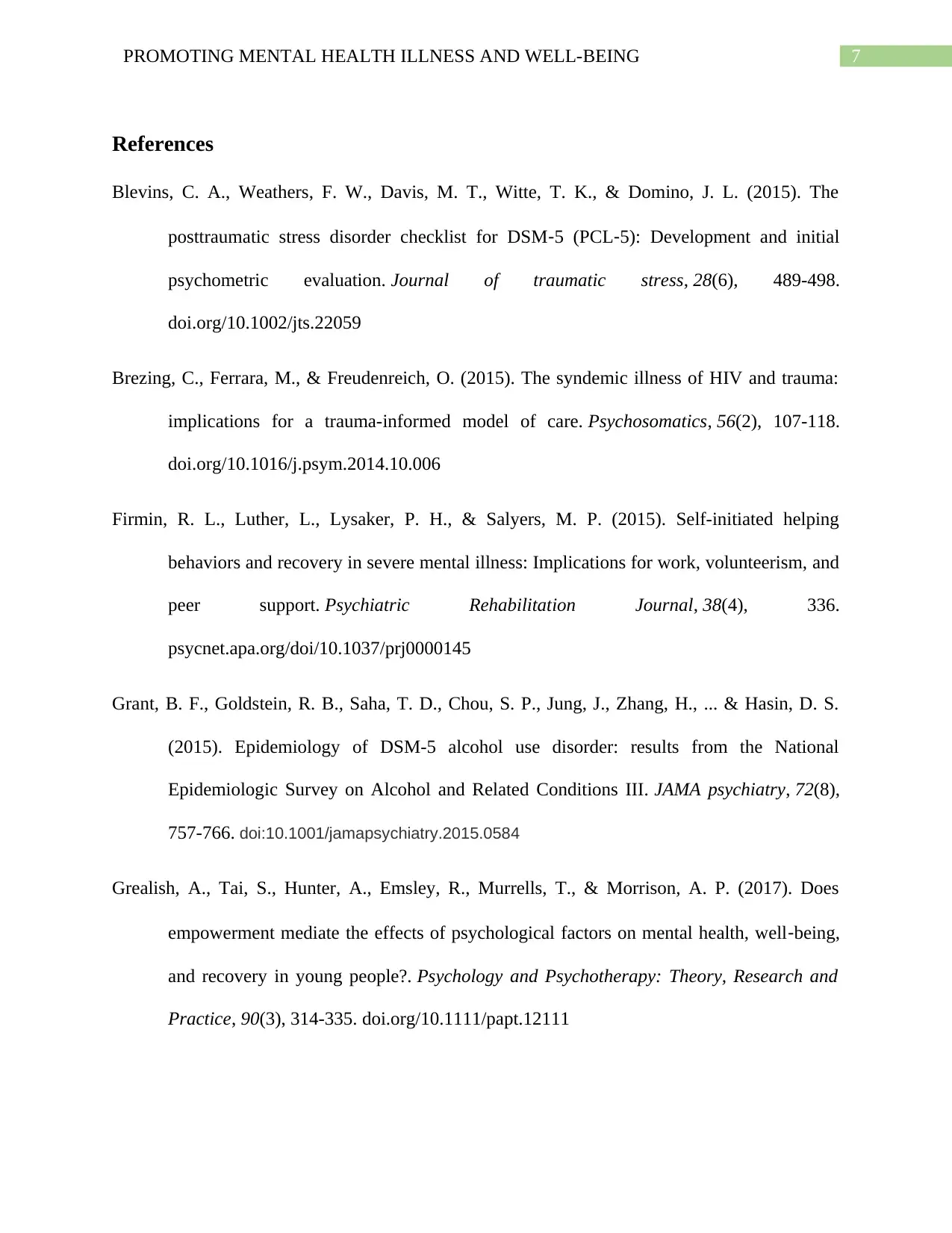
7PROMOTING MENTAL HEALTH ILLNESS AND WELL-BEING
References
Blevins, C. A., Weathers, F. W., Davis, M. T., Witte, T. K., & Domino, J. L. (2015). The
posttraumatic stress disorder checklist for DSM‐5 (PCL‐5): Development and initial
psychometric evaluation. Journal of traumatic stress, 28(6), 489-498.
doi.org/10.1002/jts.22059
Brezing, C., Ferrara, M., & Freudenreich, O. (2015). The syndemic illness of HIV and trauma:
implications for a trauma-informed model of care. Psychosomatics, 56(2), 107-118.
doi.org/10.1016/j.psym.2014.10.006
Firmin, R. L., Luther, L., Lysaker, P. H., & Salyers, M. P. (2015). Self-initiated helping
behaviors and recovery in severe mental illness: Implications for work, volunteerism, and
peer support. Psychiatric Rehabilitation Journal, 38(4), 336.
psycnet.apa.org/doi/10.1037/prj0000145
Grant, B. F., Goldstein, R. B., Saha, T. D., Chou, S. P., Jung, J., Zhang, H., ... & Hasin, D. S.
(2015). Epidemiology of DSM-5 alcohol use disorder: results from the National
Epidemiologic Survey on Alcohol and Related Conditions III. JAMA psychiatry, 72(8),
757-766. doi:10.1001/jamapsychiatry.2015.0584
Grealish, A., Tai, S., Hunter, A., Emsley, R., Murrells, T., & Morrison, A. P. (2017). Does
empowerment mediate the effects of psychological factors on mental health, well‐being,
and recovery in young people?. Psychology and Psychotherapy: Theory, Research and
Practice, 90(3), 314-335. doi.org/10.1111/papt.12111
References
Blevins, C. A., Weathers, F. W., Davis, M. T., Witte, T. K., & Domino, J. L. (2015). The
posttraumatic stress disorder checklist for DSM‐5 (PCL‐5): Development and initial
psychometric evaluation. Journal of traumatic stress, 28(6), 489-498.
doi.org/10.1002/jts.22059
Brezing, C., Ferrara, M., & Freudenreich, O. (2015). The syndemic illness of HIV and trauma:
implications for a trauma-informed model of care. Psychosomatics, 56(2), 107-118.
doi.org/10.1016/j.psym.2014.10.006
Firmin, R. L., Luther, L., Lysaker, P. H., & Salyers, M. P. (2015). Self-initiated helping
behaviors and recovery in severe mental illness: Implications for work, volunteerism, and
peer support. Psychiatric Rehabilitation Journal, 38(4), 336.
psycnet.apa.org/doi/10.1037/prj0000145
Grant, B. F., Goldstein, R. B., Saha, T. D., Chou, S. P., Jung, J., Zhang, H., ... & Hasin, D. S.
(2015). Epidemiology of DSM-5 alcohol use disorder: results from the National
Epidemiologic Survey on Alcohol and Related Conditions III. JAMA psychiatry, 72(8),
757-766. doi:10.1001/jamapsychiatry.2015.0584
Grealish, A., Tai, S., Hunter, A., Emsley, R., Murrells, T., & Morrison, A. P. (2017). Does
empowerment mediate the effects of psychological factors on mental health, well‐being,
and recovery in young people?. Psychology and Psychotherapy: Theory, Research and
Practice, 90(3), 314-335. doi.org/10.1111/papt.12111
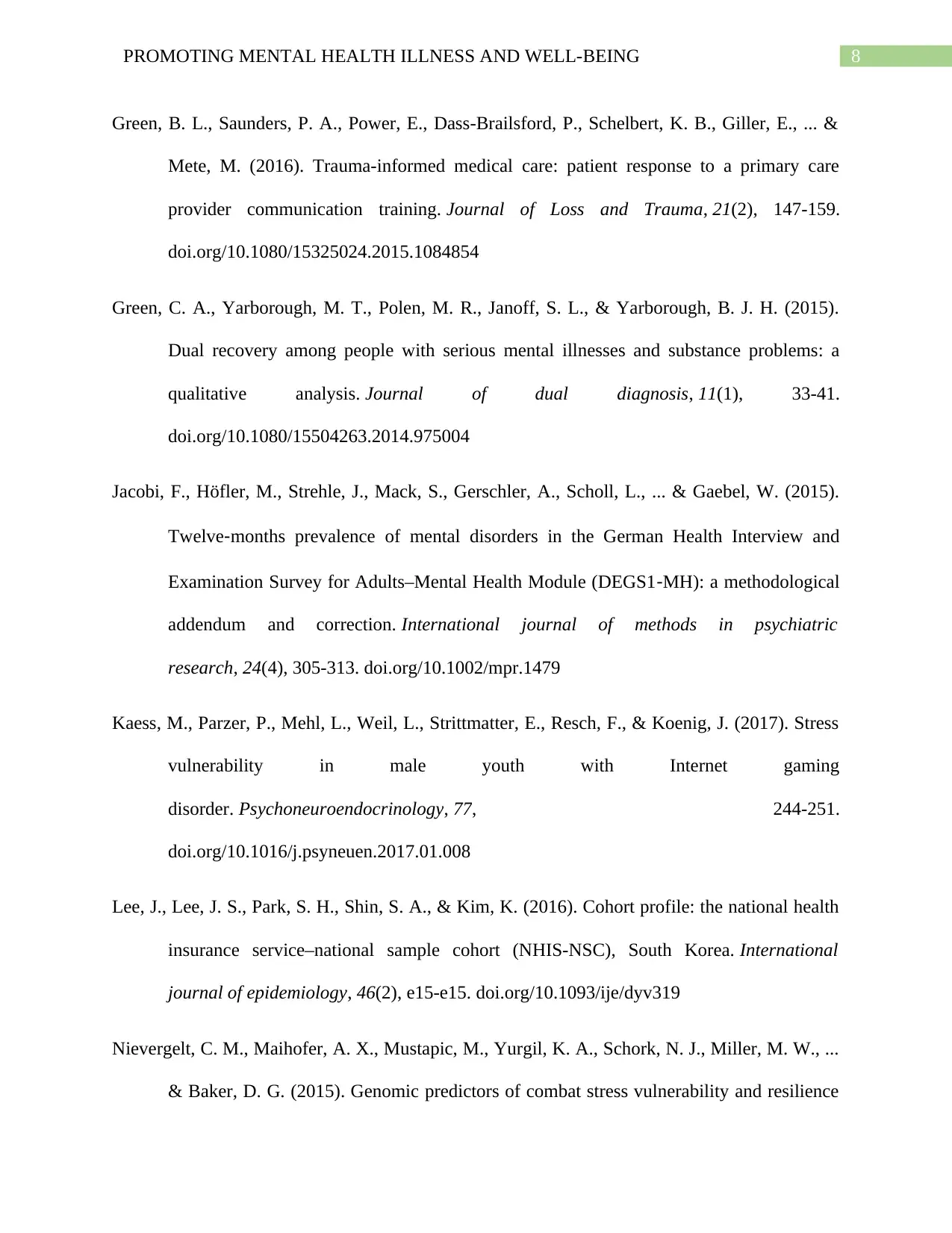
8PROMOTING MENTAL HEALTH ILLNESS AND WELL-BEING
Green, B. L., Saunders, P. A., Power, E., Dass-Brailsford, P., Schelbert, K. B., Giller, E., ... &
Mete, M. (2016). Trauma-informed medical care: patient response to a primary care
provider communication training. Journal of Loss and Trauma, 21(2), 147-159.
doi.org/10.1080/15325024.2015.1084854
Green, C. A., Yarborough, M. T., Polen, M. R., Janoff, S. L., & Yarborough, B. J. H. (2015).
Dual recovery among people with serious mental illnesses and substance problems: a
qualitative analysis. Journal of dual diagnosis, 11(1), 33-41.
doi.org/10.1080/15504263.2014.975004
Jacobi, F., Höfler, M., Strehle, J., Mack, S., Gerschler, A., Scholl, L., ... & Gaebel, W. (2015).
Twelve‐months prevalence of mental disorders in the German Health Interview and
Examination Survey for Adults–Mental Health Module (DEGS1‐MH): a methodological
addendum and correction. International journal of methods in psychiatric
research, 24(4), 305-313. doi.org/10.1002/mpr.1479
Kaess, M., Parzer, P., Mehl, L., Weil, L., Strittmatter, E., Resch, F., & Koenig, J. (2017). Stress
vulnerability in male youth with Internet gaming
disorder. Psychoneuroendocrinology, 77, 244-251.
doi.org/10.1016/j.psyneuen.2017.01.008
Lee, J., Lee, J. S., Park, S. H., Shin, S. A., & Kim, K. (2016). Cohort profile: the national health
insurance service–national sample cohort (NHIS-NSC), South Korea. International
journal of epidemiology, 46(2), e15-e15. doi.org/10.1093/ije/dyv319
Nievergelt, C. M., Maihofer, A. X., Mustapic, M., Yurgil, K. A., Schork, N. J., Miller, M. W., ...
& Baker, D. G. (2015). Genomic predictors of combat stress vulnerability and resilience
Green, B. L., Saunders, P. A., Power, E., Dass-Brailsford, P., Schelbert, K. B., Giller, E., ... &
Mete, M. (2016). Trauma-informed medical care: patient response to a primary care
provider communication training. Journal of Loss and Trauma, 21(2), 147-159.
doi.org/10.1080/15325024.2015.1084854
Green, C. A., Yarborough, M. T., Polen, M. R., Janoff, S. L., & Yarborough, B. J. H. (2015).
Dual recovery among people with serious mental illnesses and substance problems: a
qualitative analysis. Journal of dual diagnosis, 11(1), 33-41.
doi.org/10.1080/15504263.2014.975004
Jacobi, F., Höfler, M., Strehle, J., Mack, S., Gerschler, A., Scholl, L., ... & Gaebel, W. (2015).
Twelve‐months prevalence of mental disorders in the German Health Interview and
Examination Survey for Adults–Mental Health Module (DEGS1‐MH): a methodological
addendum and correction. International journal of methods in psychiatric
research, 24(4), 305-313. doi.org/10.1002/mpr.1479
Kaess, M., Parzer, P., Mehl, L., Weil, L., Strittmatter, E., Resch, F., & Koenig, J. (2017). Stress
vulnerability in male youth with Internet gaming
disorder. Psychoneuroendocrinology, 77, 244-251.
doi.org/10.1016/j.psyneuen.2017.01.008
Lee, J., Lee, J. S., Park, S. H., Shin, S. A., & Kim, K. (2016). Cohort profile: the national health
insurance service–national sample cohort (NHIS-NSC), South Korea. International
journal of epidemiology, 46(2), e15-e15. doi.org/10.1093/ije/dyv319
Nievergelt, C. M., Maihofer, A. X., Mustapic, M., Yurgil, K. A., Schork, N. J., Miller, M. W., ...
& Baker, D. G. (2015). Genomic predictors of combat stress vulnerability and resilience
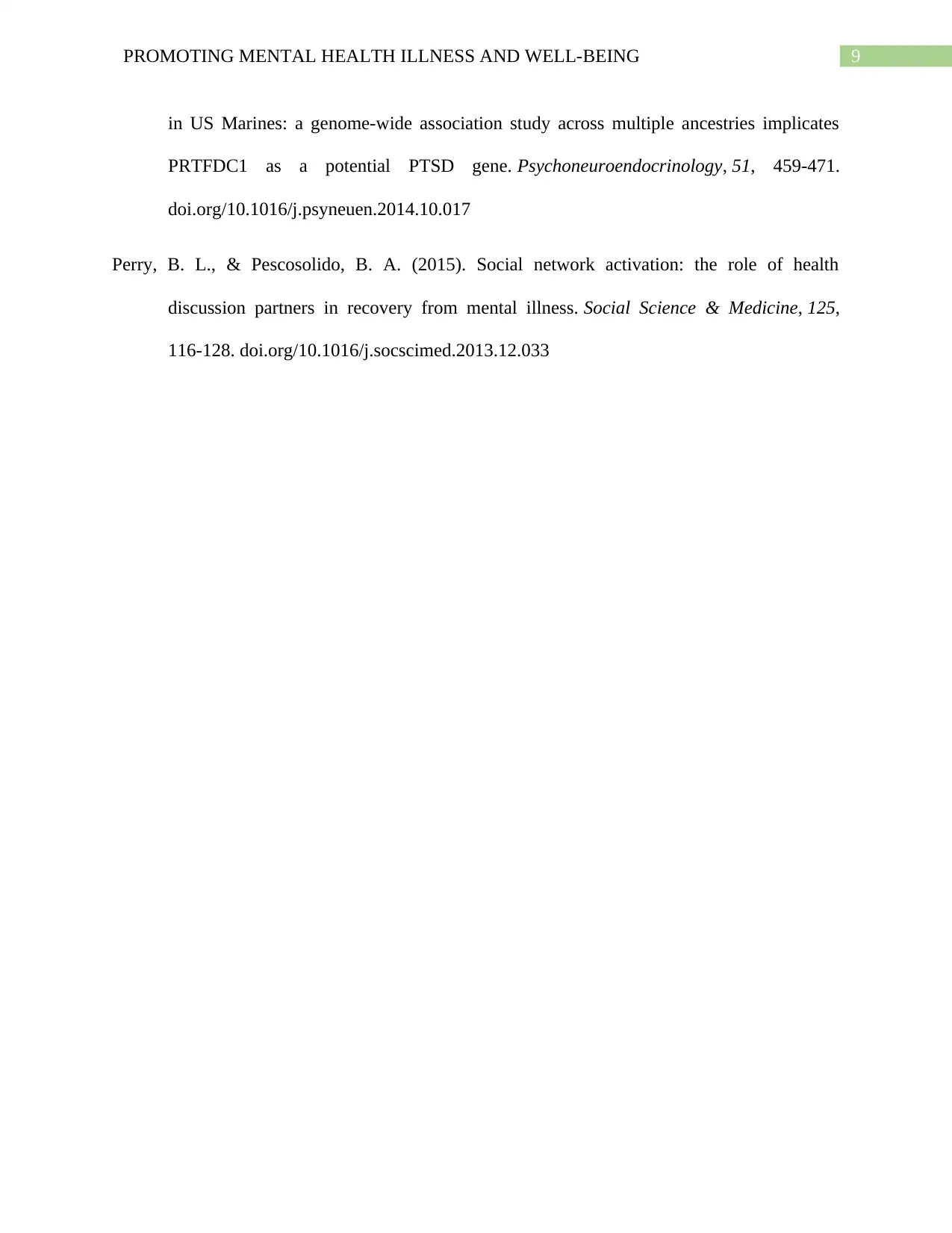
9PROMOTING MENTAL HEALTH ILLNESS AND WELL-BEING
in US Marines: a genome-wide association study across multiple ancestries implicates
PRTFDC1 as a potential PTSD gene. Psychoneuroendocrinology, 51, 459-471.
doi.org/10.1016/j.psyneuen.2014.10.017
Perry, B. L., & Pescosolido, B. A. (2015). Social network activation: the role of health
discussion partners in recovery from mental illness. Social Science & Medicine, 125,
116-128. doi.org/10.1016/j.socscimed.2013.12.033
in US Marines: a genome-wide association study across multiple ancestries implicates
PRTFDC1 as a potential PTSD gene. Psychoneuroendocrinology, 51, 459-471.
doi.org/10.1016/j.psyneuen.2014.10.017
Perry, B. L., & Pescosolido, B. A. (2015). Social network activation: the role of health
discussion partners in recovery from mental illness. Social Science & Medicine, 125,
116-128. doi.org/10.1016/j.socscimed.2013.12.033
1 out of 10
Related Documents
Your All-in-One AI-Powered Toolkit for Academic Success.
+13062052269
info@desklib.com
Available 24*7 on WhatsApp / Email
![[object Object]](/_next/static/media/star-bottom.7253800d.svg)
Unlock your academic potential
© 2024 | Zucol Services PVT LTD | All rights reserved.




